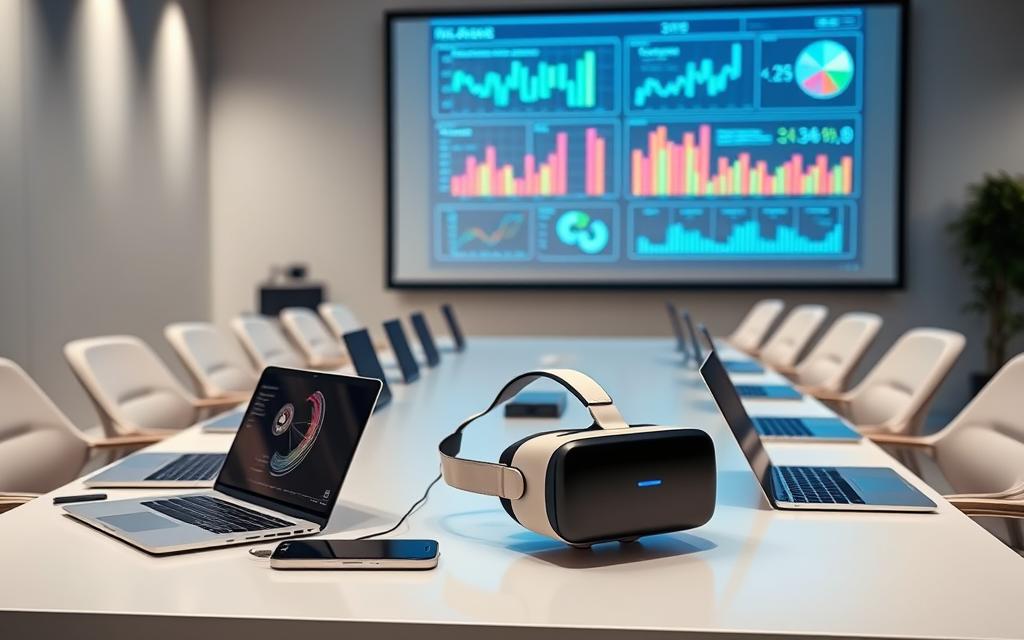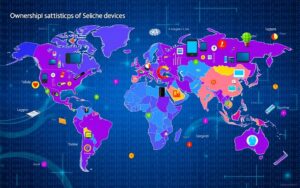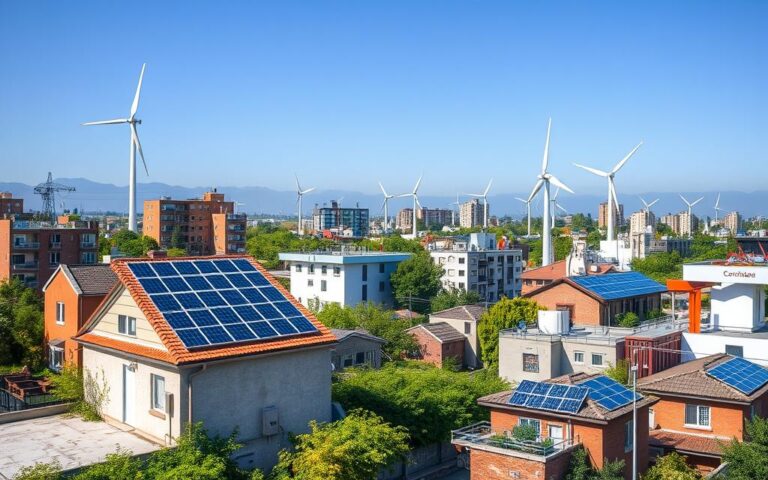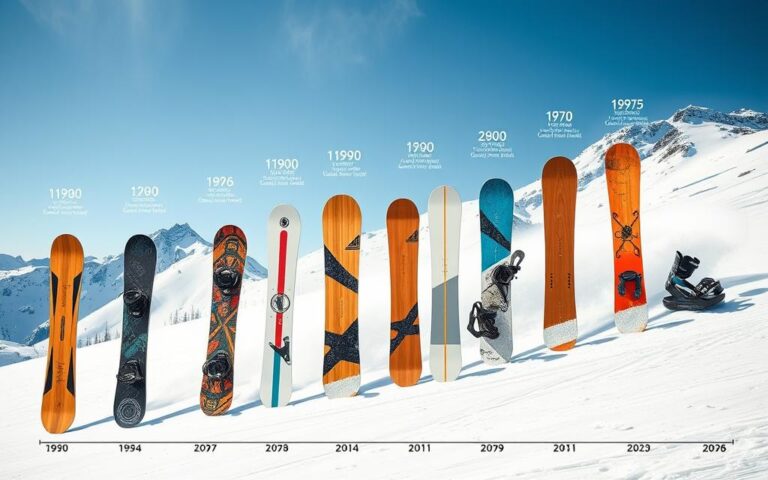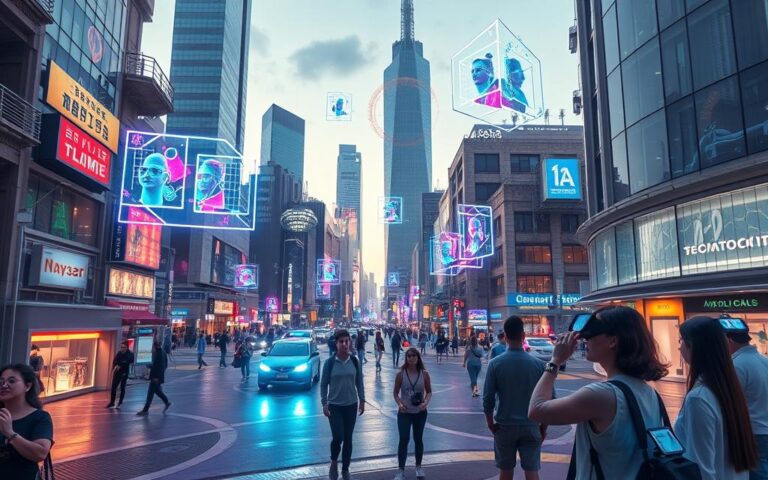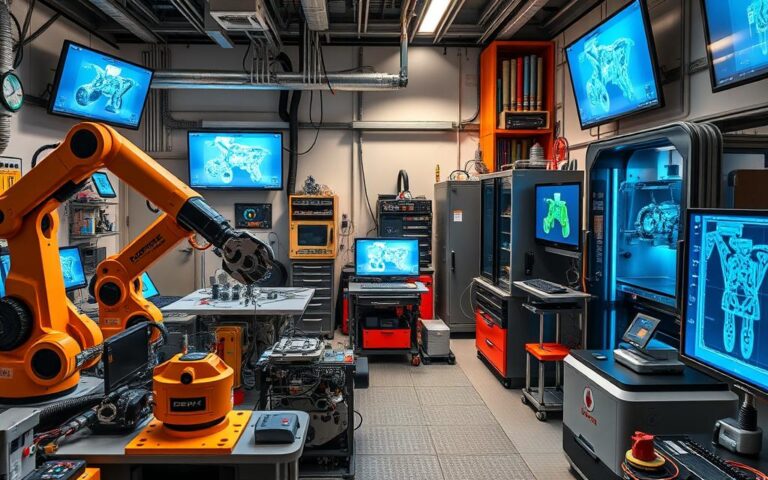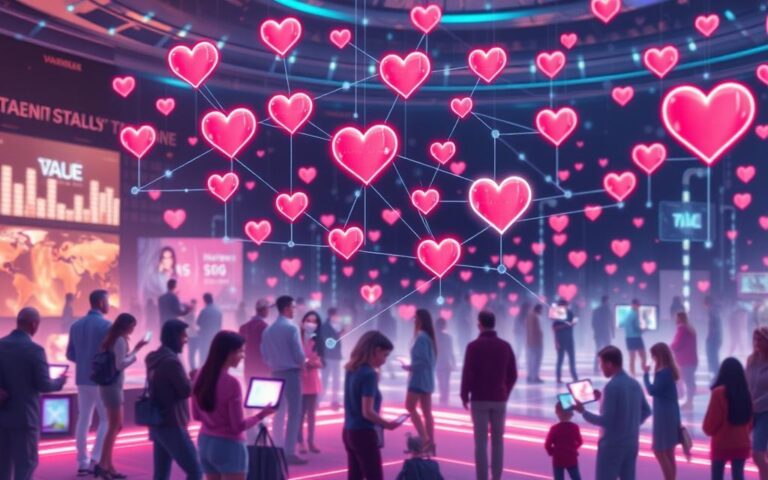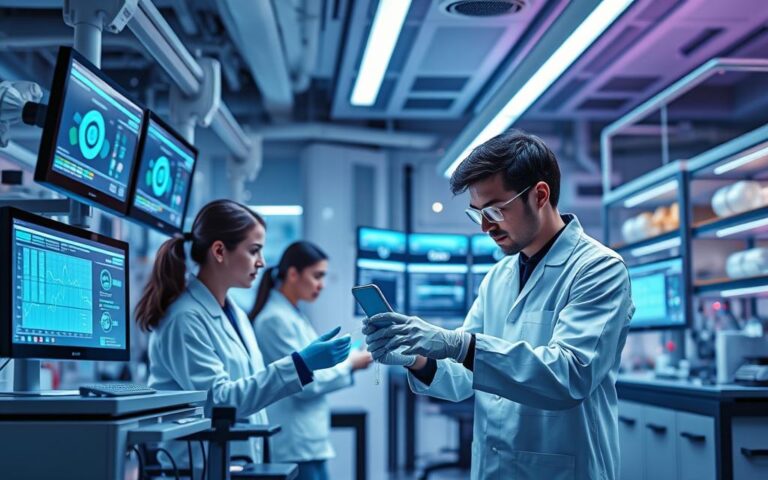Common Uses of Presentation Technologies
Today, presentation technologies are key in helping us communicate well in many areas. They started mainly in schools and businesses. They used programs like Microsoft PowerPoint. Launched in 1990, it now has 500 million users worldwide. Uses of presentation technology have grown a lot. They now include things like augmented reality and live data displays. These new tools make it more fun and engaging for the audience.
Tools like PowerPoint turn complex ideas into clear pictures. This helps with different types of talks, like educational or inspiring ones. Because we all use digital communications a lot, people expect presentations to be visually appealing. They should help what the speaker is saying and connect with the audience. This is why knowing what your audience wants is key to a good presentation.
Introduction to Presentation Technologies
In today’s digital era, presentation software plays a key role in sharing ideas. The shift from simple slides to complex programs has changed how we talk about technology in presentations. Microsoft PowerPoint, Google Slides, and Prezi lead with features for making engaging content.
Modern presentation tools use interactive items, live data displays, and videos. These help speakers grab and keep their audience’s attention in new ways. However, some users struggle with the straight path that old software follows. Too many bullet points can make slides hard to follow.
To make presentations better, sticking to design rules is crucial. These include unity, emphasis, balance, and rhythm. Keeping messages clear, simple, and using animations wisely helps keep the audience tuned in. Following the 7 x 7 rule can make slides clearer by limiting them to seven lines with seven words each.
Cloud technology has improved teamwork through shared online spaces. This lets teams work together on presentations from anywhere. Adding videos from sites like YouTube makes presentations more interesting. Also, artificial intelligence (AI) is now being used more. AI can quickly create custom presentations from just a few instructions.
The success of a presentation isn’t just about the software chosen. It’s also about how these modern presentation methods are used. It’s important to focus on keeping the audience engaged and informed.
What Are Two Intended Uses of Presentation Technologies
Presentation technologies are key in boosting effective audience communication and involvement. They mainly help in making information clear and involving the audience more during presentations.
More than 70% of speakers use visual aids, like slides and charts, to share complex data. This shows how much presentation needs are crucial in businesses. Here, being clear can change how decisions are made. Using visuals makes it easier for people to understand and remember information. This is because 83% of what we learn comes through seeing. Mixing visuals with short texts makes sure the audience not only hears but remembers the info.
The second main goal is to make presentations interactive. Around 60% of presentations now use things like polls and quizzes to keep the audience engaged. This move towards interaction keeps people interested and encourages them to take part. This strengthens the message being shared. Using technology this way helps speakers make a lasting impression on their audiences.
| Intended Use | Description | Statistics |
|---|---|---|
| Effective Communication | Utilising visual aids to simplify complex information delivery. | Over 70% of presenters rely on visual aids. |
| Audience Engagement | Leveraging interactive elements to foster real-time participation. | Approximately 60% include polls and quizzes. |
The Office: Traditional Use Cases
In today’s offices, being able to communicate well is key for teamwork and getting things done. Technologies for office presentations are crucial for improving how we talk business. They are used in everything from daily meetings to training, making complex information easier to understand.
Enhancing Meetings
Meetings get a boost from meeting enhancements that bring in visuals. PowerPoint, for instance, lets people create slides that make their messages clearer. This move from old-school tools like chalkboards to digital slides makes sharing ideas more lively.
Training and Development Presentations
Add training presentations into company growth plans helps keep teams up-to-date and sharp. Modern presentation tools keep getting better, introducing ways to make learning more engaging. They come with ready-to-use designs, interactive features, and options for using videos, which suits different ways people learn. Businesses use these tools to make their training programs more effective. To learn more about using PowerPoint for learning, check out this resource.
Houses of Worship: Unique Presentation Needs
Presentation technology in places of worship meets special needs. It makes worship services better by improving engagement with visual content. This tech helps communities connect more deeply.
Projecting Visuals for Services
Visuals are key in worship services to keep people involved. They show song lyrics, scripture, and videos to enhance the spiritual journey. Tools like EasyWorship make it easy to switch between elements smoothly.
Supporting Live Streaming and Multi-Screen Setups
More churches now stream services online because more people join from home. They use tech that allows showing visuals on many screens. This helps churches reach out to more people, making sure everyone can take part, no matter where they are.
| Feature | Benefits |
|---|---|
| Live Streaming | Enables remote access to worship services, broadening outreach. |
| Multi-Screen Setups | Enhances visibility for all attendees, ensuring inclusivity during services. |
| Presentation Software | Simplifies the preparation of service elements, reducing errors and distractions. |
| Digital Signage | Improves in-person engagement with announcements and visual aids. |
| Church Management Software | Streamlines administration tasks like member registration and event planning. |
Live Events: The Demand for High Reliability
Live events like concerts and talks need total dedication to event reliability. These situations test the limits of live event presentation technology. They ensure every sight and sound meets the crowd’s hopes.
Complex Visual Requirements
Live events call for top-notch visuals. This includes lively videos and stunning graphics. Projectors and screens must be bright enough and offer clear images, with features like HDMI for easy device switching. AV tools like mics and lights are key for a great show.
Connective technology is also essential. It helps change between presentations smoothly. Plus, lighting and sound equipment make the event memorable.
Professional Production Features
Professional production tools are critical for an event’s visual production needs. Using software like XTEN-AV helps planners choose the right equipment. It’s also vital to check power supplies and hire skilled AV technicians. This ensures any problems are fixed fast.
Making a detailed checklist helps planners. It ensures they are ready for anything, keeping the event running smoothly.
| Equipment Type | Specification Considerations | Purpose |
|---|---|---|
| Projectors | Brightness, Resolution, Connectivity | Display visual content effectively |
| Audio Systems | Microphones, Speakers, Cables | Ensure clear audio delivery |
| Lighting | Types, Positioning | Create atmosphere and highlight key areas |
| Video Walls | Size, Resolution | Enhance visual engagement |
In lively settings, it’s clear how vital high-quality visuals and reliability are. The right planning, execution, and gear are keys to success.
Academics & Education: Engaging Learning Environments
In academic settings, using presentation tech makes learning more engaging. It lets teachers share complex ideas in a clear way. This approach suits different ways of learning.
Creating Visually Rich Content
Adding multimedia to presentations boosts student interest. Videos, animations, and interactive bits make hard topics easier to understand. Schools with tech for every student see more engagement. This encourages kids to work together on digital projects.
Tools for Instructors and Students
There are many tools to help teachers teach better. These tools meet various learning needs. They include FlipGrid and Zoom for more interaction. They even help kids with special needs learn easier.
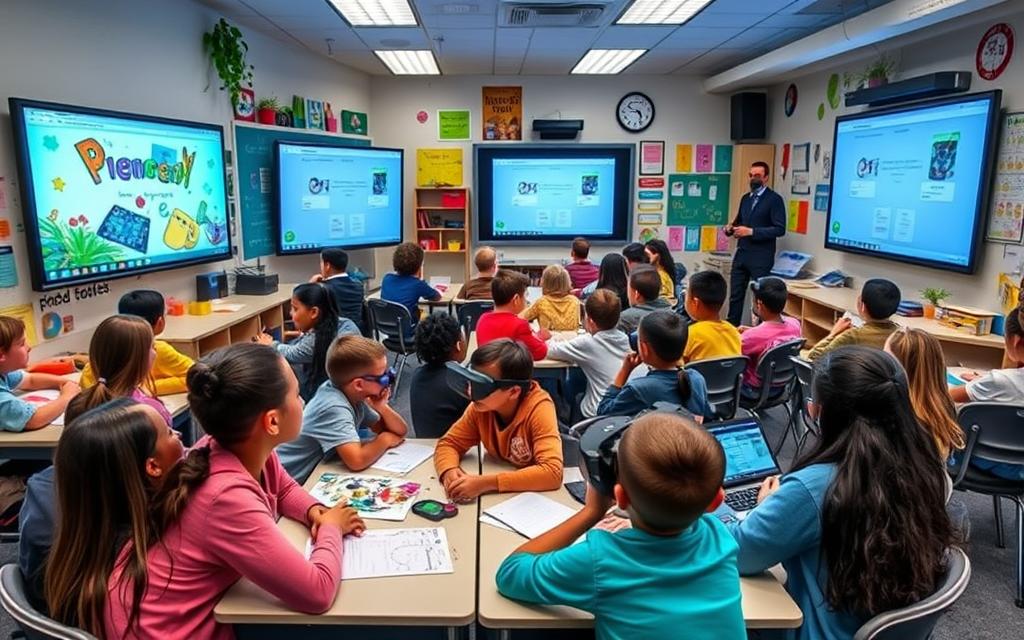
| Benefits of Technology in Education | Impact on Students |
|---|---|
| Enhanced Collaboration | Facilitates teamwork and idea sharing |
| Improved Accessibility | Support for students with special needs |
| Efficient Resource Management | Reduces reliance on printed materials |
| Instant Feedback | Promotes quicker learning adjustments |
| Engaging Learning Experiences | Increases motivation and interest in subjects |
Technology in schools readies students for their future jobs. It boosts productivity and involvement in learning. So, tech plays a big part in modern education.
Conclusion
The world of presentation technology is always changing. This provides new ways to better our communication and interaction in different areas. Knowing how to use these advanced tools well is key. This is true for office settings or new uses in events and remote worship.
Audiences want more engaging experiences nowadays. So, using evolving communication tools effectively is vital for keeping their attention.
Good presentation aids help people remember what they heard better. They make complicated info easier to understand and keep the interest up during a talk. Presenters need to keep things clear and simple. This way, they remove distractions and let the audience focus on the main points.
Using presentation aids well highlights the main ideas. It also makes it easier for people to understand stuff. This is important in a world where it’s hard for folks to deal with information from different sources.
For messages to hit home, organisations and educators must use the right presentation tools that meet the audience’s needs. Getting the approach right is crucial for a presentation’s success. To learn more about making presentations better, check out this great article on presentation aids here.
FAQ
What are presentation technologies?
Presentation technologies are tools and software that help create and share visual content. They make live presentations more engaging and help communicate better in various environments.
How have presentation technologies evolved over time?
They’ve grown from simple platforms like PowerPoint to advanced tools. Now, we have holograms, augmented reality (AR), and live data visualizations. These cater to the changing needs in offices, schools, and live events.
What are the primary intended uses of presentation technologies?
They aim to improve how we communicate complex information and engage audiences. By offering immersive experiences, they encourage people to participate more during presentations.
How are presentation technologies used in office settings?
In offices, these technologies help make meetings more visual with slideshows. They’re also great for training, helping staff remember and understand better.
What unique needs do houses of worship have for presentation technologies?
They use these technologies to show song lyrics, scriptures, and videos. More and more, live streaming and using multiple screens are being used to better engage the congregation.
What are the key considerations for presentation technologies in live events?
For live events, it’s important these technologies are reliable and can handle complex visuals. They must ensure a professional look, integrating graphics and videos smoothly for the best audience experience.
How do presentation technologies enhance academic settings?
In education, these technologies are key for engaging lessons. They give teachers flexible tools for various teaching styles and support collaborative learning.
